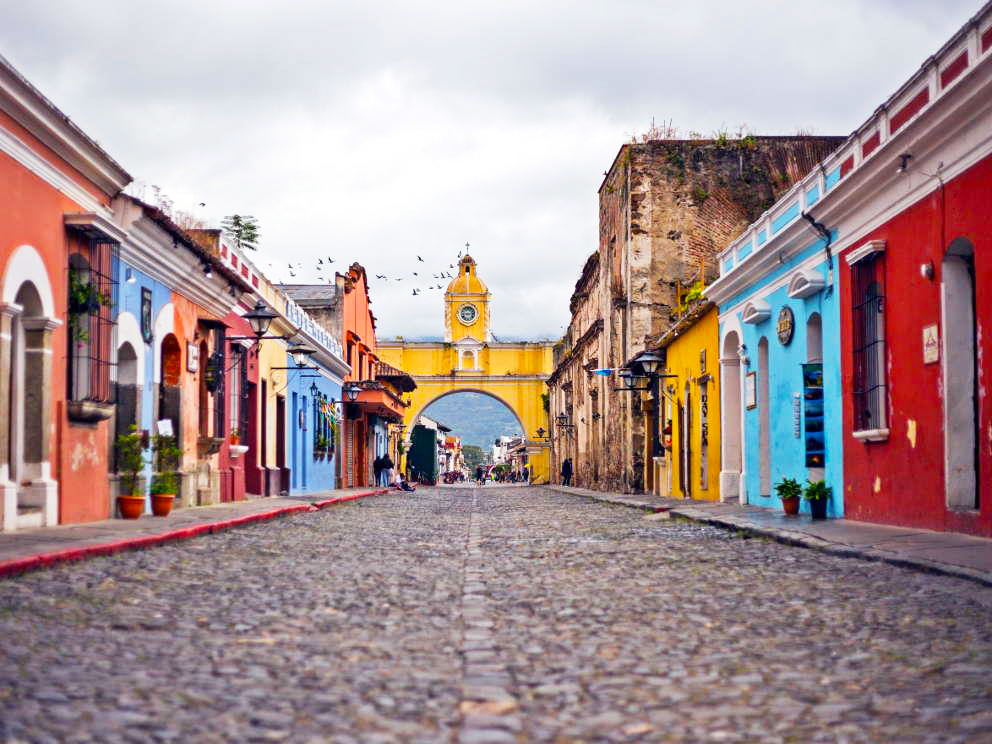With it rich volcanic soil, mountainous terrain and varied micro-climates, Guatemala is a perfect country for coffee cultivation. Guatemalan green coffee beans are the delight of roasters and coffee drinkers alike. With its wide array of growing regions Guatemala encourages a diverse range of outstanding flavor profiles. Together with our in-country sister company, we’re proud to source some of the best unroasted Guatemalan coffees.

Colorful Antigua, Guatemala
Guatemalan Coffee History
Centuries of agricultural history have transformed Guatemala into the spectacular coffee origin it is today. Jesuit missionaries brought coffee plants to their monasteries in Antigua in the mid-1700s to decorate their monasteries. But when the economy started to fail, coffee overtook indigo as Guatemala’s main cash crop. The rise of coffee as a cash crop was bolstered by inputs from large European landowners who helped launch Guatemala as one of the world’s leading coffee producers. Coffee production in Guatemala became a major industry in the 19th century.
It wasn’t until the 1950s that past inequalities were addressed by the Agrarian Reform Law, which redistributed land from the estates to the indigenous people who worked them. This sparked the beginning of a violent Guatemalan civil war in 1954 that lasted until 1996, severely hindering progress in the Guatemalan coffee industry.
The Asociación Nacional del Café (ANACAFE) was established in 1960 to represent all the coffee producers in Guatemala. Their work also includes the Analab coffee laboratories and initiatives for coffee research, cultivation, processing, and expansion throughout the country, bringing Guatemala back onto the world stage as an origin with a stellar reputation today.

Coffee cherries being delivered to Pastores wet mill
Guatemala Coffee Production
From 2009-2011, Guatemala produced an average of 3.5 million 60kg bags annually. However, production has been slowly decreasing over time. Years of low C-market prices, hurricanes and COVID-19-related challenges have taken their toll on coffee farms and farmers. Overall, coffee production volume decreased to an estimated 3.4 million bags in 2022. Meanwhile, costs related to production, including fertilizer and labor, have increased by 32% and have negatively impacted coffee volumes.
The Guatemalan coffee harvest generally runs from December to March/April. Harvest laborers are typically from Guatemala. With a spike in migration to the United States in search of better prospects, seasonal labor is getting hard to come by. Some farms have heavily reduced output on their farms because there simply aren’t enough people to do the work. Many landowners are also selling their farms. Some growers are turning to avocado and rubber crops for higher profit margins.
Coffee trade in Guatemala is worth about $700 million (a little less than 1% of Guatemala’s GDP). The coffee industry employs more than 125,000 families throughout Guatemala, and around 44% Guatemala’s coffee is produced by smallholders working less than 2 hectares of land. But Guatemalans depend upon coffee. The coffee sector has the highest employment rate in Guatemala, creating over half a million jobs every year.
Over 98% of Guatemalan coffee is shade-grown and roughly 96% of it is Arabica. Green coffee beans from Guatemala is almost always washed. However, some producers are experimenting with natural and honey processing as a means of getting more cash for their crops and more renown at competitions. ANACAFE also offers training on these methods to promote differentiation as demand rises. Of the 30 lots of coffee to rank on the 2022 Guatemala Cup of Excellence, 16 were washed, 11 were natural, and three were honey-processed. That said, the rising C-market put the brakes on innovation, since farmers tended to be more satisfied with the price they fetched from selling parchment.
The biggest consumers of Guatemalan coffee – and thus the biggest coffee roasters of Guatemalan green coffee beans – are the United States (44%), Japan (11%) and Canada (8%).

Guatemalan coffee producer with Natural Process coffee
Common Guatemala Green Coffee Varietals
After leaf rust decimated coffee farms across Central America in 2012, many labs ramped up exploration of rust-resistant varietals. In Guatemala, around 20% of the coffee is made up of Sarchimor and Catimor varietals due to their rust resistance. 70% of coffee is Caturra, Catimor and Catuai.
Traditional Guatemalan varietals, however, include Bourbon, Caturra, Catuai, Pache, and Typica. In recent years, newcomers such as Gesha, Pacamara, Maragogype, and Maracaturra have cropped up. Roughly 94% of all of the coffee grown in Guatemala is Arabica, with the remainder of the country’s output being split among other species such as Robusta.

Washing coffee at a micro-mill in Huehuetenango
Guatemala Coffee Producing Regions
Although 204 out of 340 municipalities in Guatemala grow coffee, ANACAFE defines the country’s eight coffee regions as Acatenango Valley, Antigua Coffee, Traditional Atitlán, Rainforest Cóban, Fraijanes Plateau, Huehuetenango, Nuevo Oriente, and Volcanic San Marcos to improve Guatemalan coffee marketing around the world. With active and dormant volcanoes and terrific biodiversity, Guatemala easily has over 300 micro-climates. Rainfall can vary from 800 to 5,000mm a year and coffee is grown at dizzying heights – 1,300 to 2,000masl.
Acetenango Valley
Acetenango Valley is in the south of Guatemala, along the slopes of the active Fuego volcano. But the volcano’s output supplies the land with rich, nutritious minerals. Temperatures range from 57-88ºF and average rainfall is 48-72in. The altitude ranges from 4,300 – 6,500 feet, and the land is covered in dense forest. In the cup: high acidity, fragrant aroma, balanced body, clean and lingering finish
Antigua
Antigua, one of Guatemala’s most famous departments, lies a little to the east. The land is characterized by rich volcanic soil from the three nearby volcanoes, low humidity, ample sunlight, and cool nights. Temperatures range from 64-72ºF and although the region experiences less rainfall, the moisture-retaining volcanic pumice in the soil keeps vegetation irrigated. In the cup Antigua is a delight: elegant, well-balanced, rich aroma, and high sweetness
Traditional Atitlán
Traditional Atitlán coffee grows in soil that’s the richest in organic matter in Guatemala. Coffee is planted on the volcanic slopes around Lake Atitlán, and the microclimate is heavily influenced by daily Xocomil winds that blow over the cold lake waters. The Temperature ranges from 68-72ºF and rainfall averages 72-92in per year. In the cup, Atitlán offers a delightful aroma with bright citrus acidity and a full body.
Rainforest Cóban
Rainforest Cóban green coffee is cultivated on rolling hills of limestone and clay soil. Rain is plentiful in this department (120 – 160in per year), and the tropical region is often engulfed in a cool cloud mist. In the cup, coffees from Rainforest Cóban offer fresh fruit notes, well-balanced body, and a pleasant aroma
Fraijanes Plateau
Fraijanes Plateau is found on the high slopes of three active volcanoes that deposit fresh mineral boosts of ash every so often. The distinct dry season bathes the region in sunshine, which allows producers to sun-dry their coffee. Temperature range from 54-79ºF and, at 60-120in per year, rainfall can be plentiful. In the cup, coffees from this department are bright & aromatic with a well-defined body.
Huehuetenango
Huehuetenango farms sit high in the mountains ranging from 5,000 – 6,500 feet (2,000masl). This renowned region owes much to the dry, hot winds that come in from the mountains of Mexico’s Tehuantepec plain. The additional heat layers protect Huehuetenango from frost and enable coffee to grow at dizzying heights. The fact that Huehuetenango farms are so high up and remote means that producers must often set up their own micro-mills. Fortunately, Huehuetenango is also blessed with numerous rivers that facilitate washed-process coffee. In the cup, Huehuetenango has intense acidity, full body and winey notes
Nuevo Oriente
Nuevo Oriente has been populated by smallholders since the mid twentieth century. Now coffee is growing in popularity and larger estates are popping up. Today, coffee is helping the region blossom into a vibrant community. With average rainfall of 72 – 80in per year, temperatures ranging from 64-77ºF and soil fed by volcanos, Nuevo Oriente appears poised to become a strong coffee-producing region. In the cup, Nuevo Oriente is well-balanced and full-bodied with rich chocolate notes
Volcanic San Marcos
Volcanic San Marcos green coffee is planted in the warmest and wettest of Guatemala’s eight coffee regions. Unpredictable rainfall means that coffee is processed and pre-dried in the sun before it completes the drying stage in a Guardiola dryer. Temperatures average 70-81ºF and at 160-200in per year, rainfall is plentiful. San Marcos offers a distinctive profile with delicate floral notes, pronounced acidity and a good body.

Producers in Cubulco sorting coffee
Quality Guatemala Green Coffee
Coffee in Guatemala is graded based on bean density and growing altitude. When coffee grows at high altitudes, the coffee cherries mature more slowly. This allows the fruit to take in more nutrients, resulting in denser, sweeter coffee beans that are considered higher quality. Guatemala green coffee quality distinctions are as follows:
- above 1,370masl = Strictly Hard Bean (SHB);
- between 1,066 -1,370masl = Hard Bean;
- between 764-1,066masl = Extra Prime Washed (EPW)
What does coffee from Guatemala taste like?
The flavors of coffee from Guatemala vary as widely as the hundreds of microclimates the coffee grows in. The different terroirs shine through each cup profile, making Guatemala a favorite region for many coffee drinkers. Flavors can range from distinct chocolatey tones to delicate floral profiles.
Three of Genuine Origin’s favorite regions include Huehuetenango, with its complex fruity flavors and light body; San Antonio, with sweet, rich dark-chocolate profiles; and Cubulco, with floral and bright acidity coffees.
Genuine Origin in Guatemala
Genuine Origin’s sister company in the region is Volcafe Guatemala, a long-standing exporter always on the lookout for new ways to connect with producers. Facilities include the famous Pastores wet mill in Antigua and two dry mills near Guatemala City. To reach producers in remote regions like Cubulco, Volcafe Guatemala organizes and finances trucks to operate as drop-off points for groups of farmers in an area.
Carlos Umanzor, Specialty Coffee Trader at Volcafe Guatemala, sees growth on the horizon for the producer network, particularly in Huehuetenango. “We have more active technicians sending updates, and we see crops and yields increasing. Last year was a good year for Huehue,” he says.
Overall, it’s been a challenging period to source green coffee in Guatemala due to fluctuating differentials. High market prices have encouraged producers to sell cherry instead of parchment, and while they are benefitting from extra profits, much of that will go to covering increased costs for fertilizer and production. In addition, competition is fierce from intermediaries who buy up most of the cherry, forcing exporters to rely on them and pay higher prices for a limited supply.
For this reason, Volcafe Guatemala’s goal is to set up smaller washing stations or mills throughout the coffee-producing regions to collect cherry daily. These farmer business units would create a constant supply of traceable coffee to the warehouse in Huehuetenango and strengthen their presence in each region.
La Morena – Gender-Equity Program
When the La Morena women’s microlot was launched in 2016, the initiative kicked off with four producers. Now, the series has expanded to include women in Huehuetenango and Cubulco, with over 700 and 150 women, respectively, contributing to the empowering microlot today.
Candelaria is also an exclusive Genuine Origin profile from Huehuetenango. The coffee’s distinct cup character: milk chocolate, caramel, and roasted almond with a bright acidity will stand out on any cupping table.
More Guatemala green coffee microlots are on the table as Carlos cups outstanding coffees that are well worth setting aside. We look forward to growing our relationships with producers in Guatemala and seeing the positive impact that Volcafe Way has on coffee communities in the country.
Find more about our Guatemala green coffee collection at Genuine Origin’s Guatemala portfolio on our website: https://www.genuineorigin.com/guatemala






